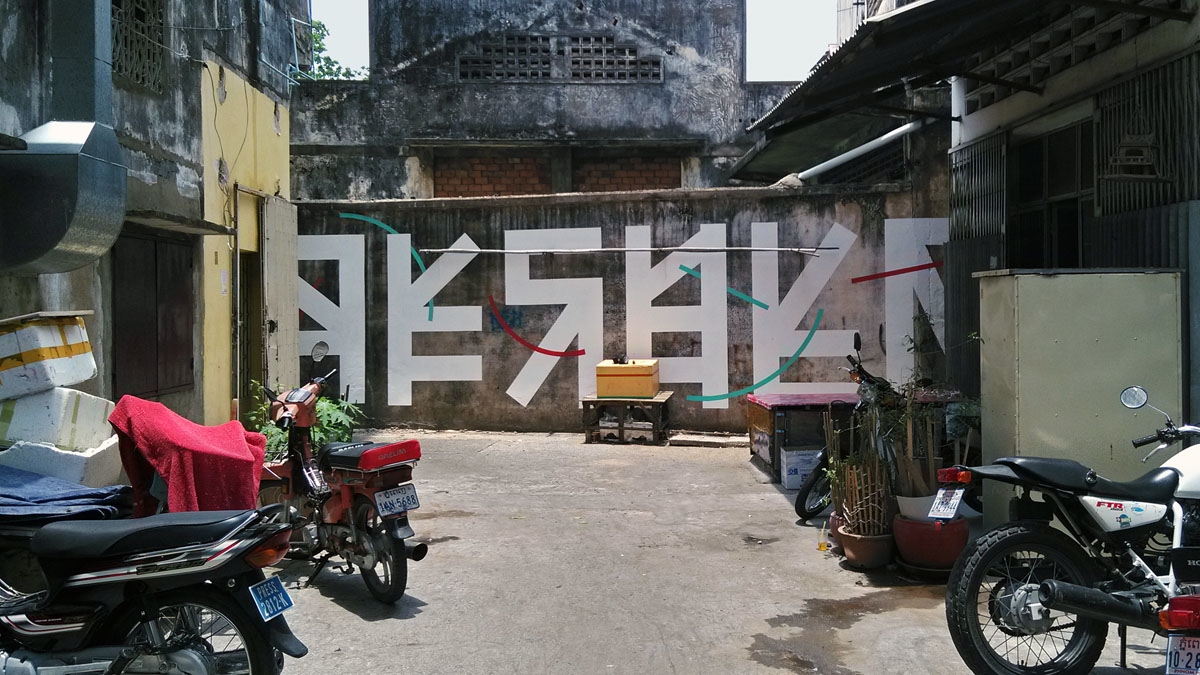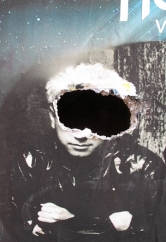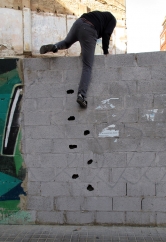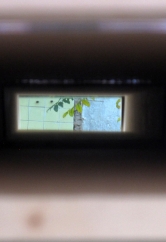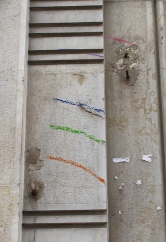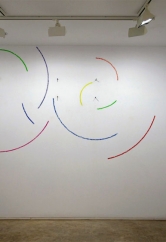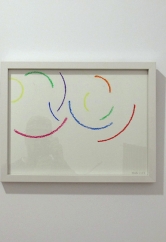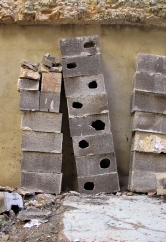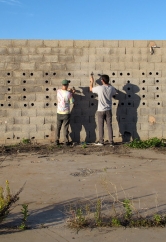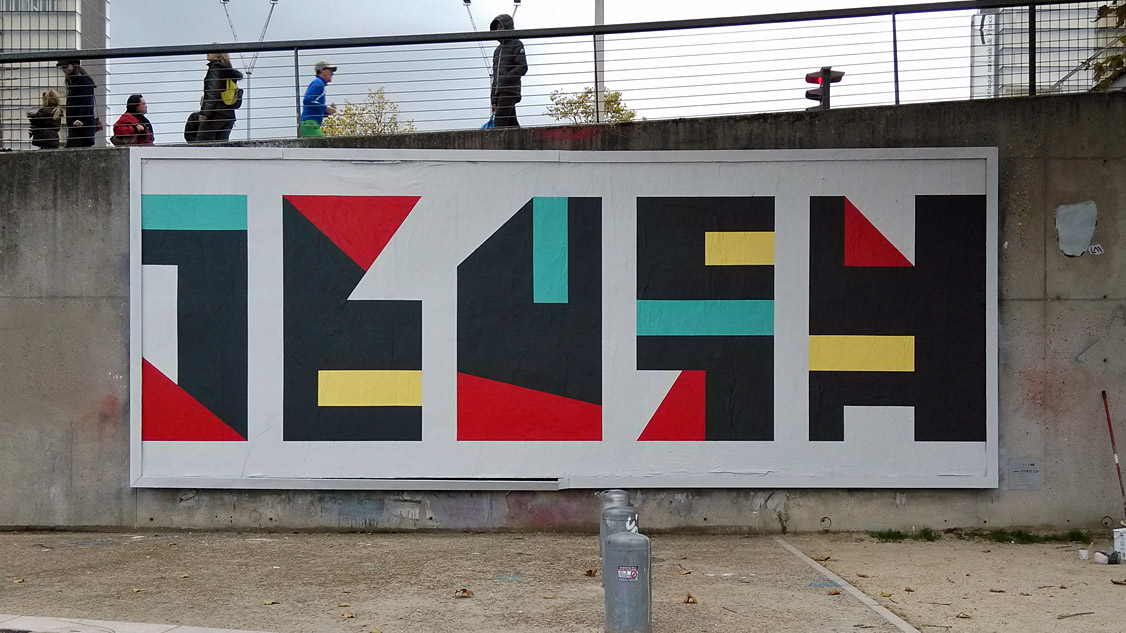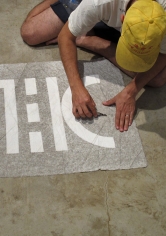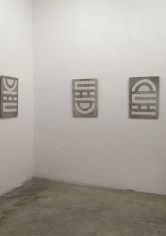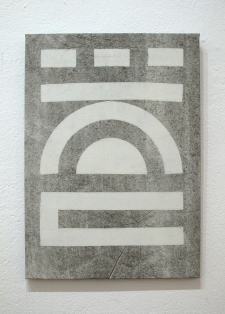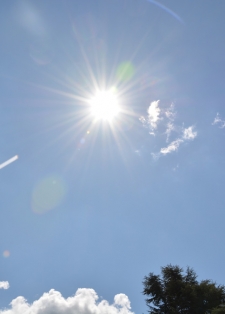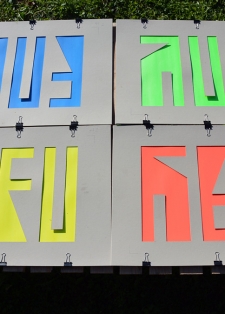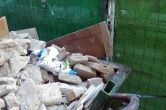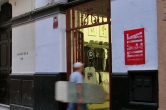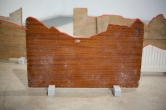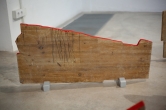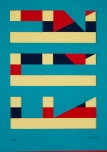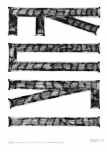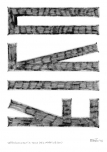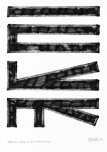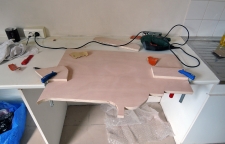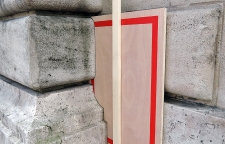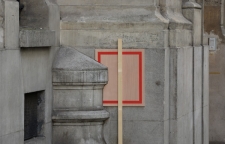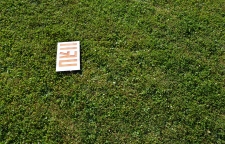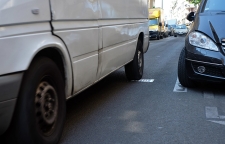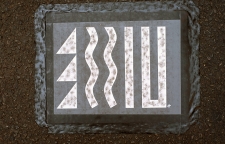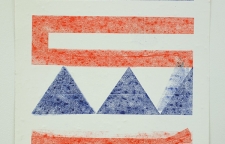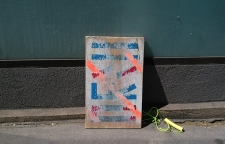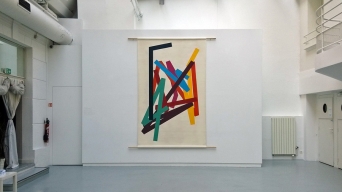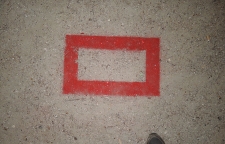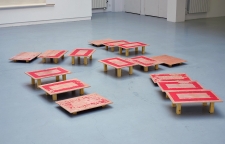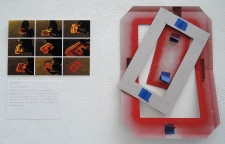Phnom Penh, Cambodia
April 2015
Invited by the Institut Français and the artists Chifumi and Théo Vallier.
Category: 2015
Lugares Comunes
Luce + Eltono
SET Espai d’Art
Plaza Miracle del mocadoret 4, Valencia, Spain
November 13th 2015 – January 12th 2016
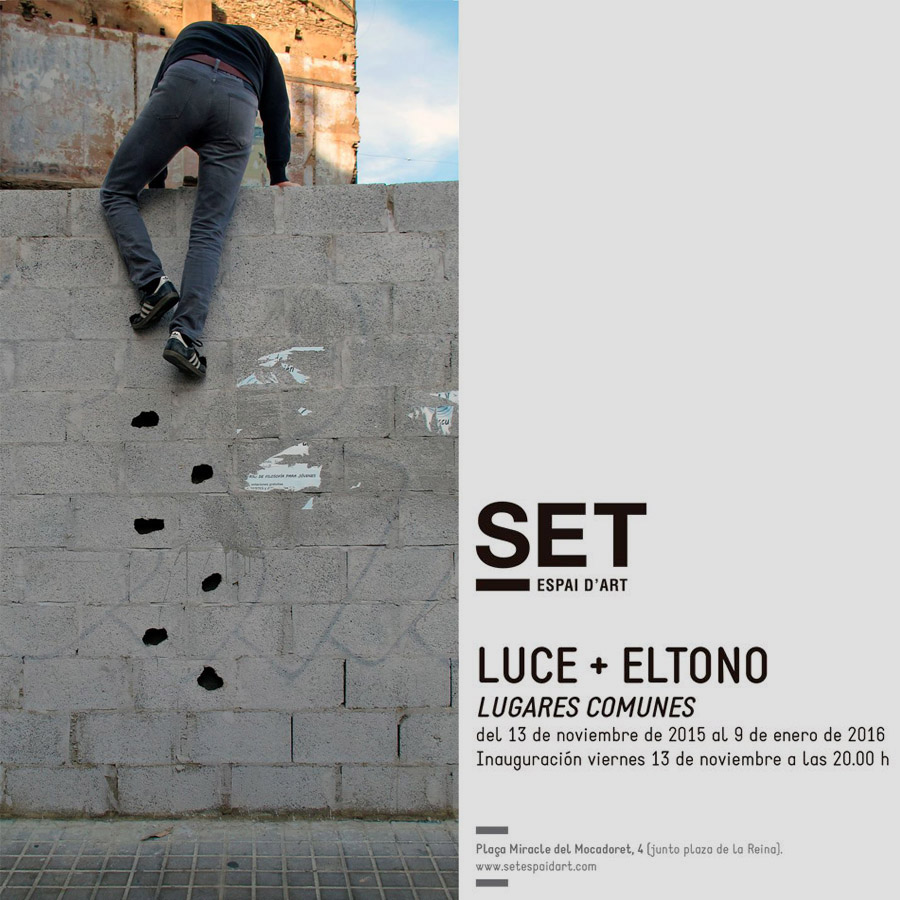
“Lugares Comunes” was my first collaboration with Spanish artist Luce. We worked during three weeks on four installations based on observations and experiences we had around the city of Valencia.
1 – Escalera Butrón (break-in ladder):
This piece is about making holes in abandoned plot walls so we can facilitate the access to their interior. The holes were punched following a zig-zag pattern so that they could be used as a ladder. We used hammers and chisels and the holes came out irregular because they were made quickly and illegally. The size had to be big enough so a foot could fit in it. In the gallery, we showed five full scale “break-in ladders” made of wood. They were exact life size replicas and included the same shape, dimensions and arrangement for each hole. Reproducing the holes in wood had to be done rigorously and required precision and accuracy, which was a direct contrast to the way the holes were randomly produced on the street with a hammer and a lot of adrenaline.
2 – Periscopio (periscope):
This is a hollow omega shaped structure we build to be placed on top of deserted plot walls. Inside, a set of mirrors allowed us to literally see through the wall. We attached wheels so the artifact could be moved horizontally offering the viewer a proper exploration of the inside of the plots. In the gallery, we built a wall to support the periscope and showed a video of how people used it to see through different walls around the city.
3 – Asientos Acondicionados (seat conditioner):
All around the city, we observed a lot of unused L shaped brackets on places where an air conditioning unit used to be installed. We decided to exploit them to install a seat. The seat and the backrest leaned on the L squares mounted on the facade of the buildings. For the exhibition, we installed L brackets to set-up one chair and we showed four photographs of one of us sitting on it. These self-portraits served as a witnesses to the performances in the street as well as an opportunity for the public to see the artists enjoying the devices as they contemplate the city from a novel point of view.
4 – Compas (compass):
We used eight wood sticks of different lengths with a hole drilled on one side and a wax crayon attached to the other. In the street, we looked for unused screws coming out of the walls to hang them. These screws became center points to draw curves playing with the restrictions imposed by the position of the screw, the size of the stick and the surrounding elements. Inside the gallery, we reproduced a real situation that we observed in the street formed by eight screws and used the sticks to draw lines on one of the gallery walls. We made eight small scale drawings on paper that serve as a proof of the completion of the mural.
Extras:
Additional actions we did during the preparation of the show. Experimentations that we didn’t show in the exhibition but that were part of the process.
Pictures of the show:
Le Mur XIII
“33,333”
Port de la Gare Paris 13e
Performance Nº48 – October 17th and 18th 2015
www.lemur13.com
Aléas
Delimbo
C/Pérez Galdós nº 1 Acc., Seville, Spain
October 8th 2015 – January 12 2016

6 Lienzos (6 canvases):
Interested in using the street as a workshop, I created a printing system that takes advantage of the passage of cars to generate works on canvas.
U.V.:
In this experiment, I take advantage of sunlight to produce prints. The procedure involves placing a cardboard template on a painted fluorescent color paper and leaving it in the sun for a certain period of time.
7 lines passing through 4 points:
Random painting exercise – I painted 7 lines each one built by linking 4 points together. The coordinates of the points and the order of the colors are chosen at random.
Punto de encuentro (meeting point):
Wooden planks found in the streets of Seville during the trips I made between my hotel and the gallery. Each table is modified making a cut that reproduces the route that I took, the table under my arm, between the place where I found the wood and the gallery.
Collages:
Each collage is comprised of the combination of 3 different templates, 3 colors and background paper (yellow). I tried different combinations by changing the order of the designs and colors making unique collages where no two combinations are alike.
Verso:
This exercise is a non-exhaustive comparison of how different pens react to different papers. Depending on the weight of the paper, the drawing appears more or less defined on the back of the sheet. I drew 91 versions of a modular drawing and displayed them showing the back side of each paper.
Exhibitions view:
Text (in Spanish) by Guillermo López Gallego:
Eltono: lo que hay debajo de la playa
Paso largos periodos fuera de Madrid. La última vez que volví, sentí una penetrante melancolía ante las piezas plateadas de la M-30, las puertas cubiertas de tags, las letras redondeadas. Sentí como dolor lo que ya sabía: el graffiti es una conversación en cada ciudad, y yo me estaba perdiendo la de la mía.
Como una marca con ínfulas, he visto piezas en Abijan, Berlín, Bogotá, Bruselas, Buenos Aires, Zaragoza, Conakry, Freetown, Hamburgo, Monrovia, Nueva York, París, Panamá, Portland, Santander, San Petersburgo, Seattle, Sevilla, Tallin, Riga, Vilna… Pero no he seguido esas conversaciones.
Y eso es lo primero que me viene a la cabeza al pensar en la obra de Eltono.
*
Parece que hay dos maneras de escribir sobre Eltono y su obra.
Hay quien opta por el enfoque histórico. Este se puede encontrar en otros sitios, y de la mano del propio Eltono en la publicación Line & Surface. Es sabido: Otone, GAP (crew a la que Eltono todavía mencionó en 2009), los trenes parisinos; cómo llegó a Madrid en 1999 y cómo reaccionó a la saturación del centro, es decir, la aparición de Eltono, la adopción de un icono que ha ido refinándose, adoptando una estética minimalista, limpia, sencilla, y una técnica depurada y sin aerosol.
Luego están los relatos sobre la experiencia de conocer la obra de Eltono en las calles de Madrid. Entiendo el aire de epifanía que tienen aquellos, porque recuerdo pasar el verano de 2001 buscando a Eltono en las puertas y rejas de Lavapiés. Me acuerdo de una pieza en los cuarteles de Daoíz y Velarde en 2006, la primera que vi con tres colores; otra envejecida al final de Cuatro Caminos, en 2009. Hace dos años, descubrí una obra antigua en la calle Infantas, cerca de Colmenares, que reaparece periódicamente bajo los carteles que anuncian conciertos y fiestas.
He podido apreciar, como muchos otros, la importancia que el contexto tiene en la obra de Eltono, su forma de señalar texturas en la ciudad y de ennoblecer y recuperar espacios. Y no creo que se pueda acusar a Eltono de contribuir a la gentrificación de los lugares donde trabaja; conociendo su respetuosa reivindicación de la artesanía y la forma en que trabaja con las comunidades, seguro que ha pensado en ello.
He observado también, siguiendo su trabajo en museos y galerías, la inteligencia con la que ha sabido llevar a esos contextos la esencia del trabajo de calle. Cualquiera que haya visto las obras de taller de Blade sabe que la transición de la calle al circuito comercial no es fácil.
Eltono (y aquí empieza mi intento de ir más allá de las dos maneras de escribir que acabo de mencionar) ha sabido inducir los principios generales del trabajo de calle, y trasladarlos al taller. Ha sabido encontrar, creo, dos claves del graffiti que le permiten crear arte urbano fuera de la calle. Quizá porque Eltono es francés, siempre las imagino en términos franceses.
En primer lugar, ha extraído y refinado la idea de contrainte, de restricción, propia del Oulipo. La obra de taller de Blade, como la de Seen y Lee y otras leyendas del graffiti, tiene algo kitsch, porque se limita a usar los aerosoles sobre el lienzo en vez del vagón, y no sabe incorporar la forma en que la calle determina el graffiti, el peso de tener el tiempo contado, la interacción con el público y la intemperie: su pintura no es obra sino reproducción.
Eltono, en cambio, ha identificado algunos elementos del graffiti que le permiten crear en el taller obras de calle: la aleatoriedad y la intervención acelerada del paso del tiempo, por ejemplo. Y lo hace, como él mismo dice, de manera casi científica: «imagino un protocolo, decido unas reglas, las ejecuto y observo los resultados». Es decir, a la manera de Pérec y Queneau.
En segundo lugar, Eltono ha ahondado la raíz situacionista del graffiti. No hablo de las banales pintadas inspiradas en la obra de Debord y Vaneigem, desde mayo del 68 hasta hoy. Me refiero al enfoque situacionista, de nuevo casi científico, del paseo, y el uso que de él hace Eltono, por ejemplo, en obras desarrolladas en Vitoria y Pekín.
(Y al détournement, también situacionista: la subversión de la publicidad de cerrajeros y pintores de brocha gorda, que también habla de su conocimiento de la ciudad.)
Es posible que haya contradicción en someter la artesanía del paseo situacionista al rigor de la contrainte del Oulipo. Pero Eltono parece resolver ese problema por la vía de la inmanencia, como podría decir François Julien: contrainte y deriva no se aniquilan, sino que crean.
*
Oulipo y situacionismo. Recuerdo también que Javier Abarca, cuyos estudios de la obra de Eltono son brillantes, habla de Daniel Buren y Space Invader en algunos de ellos. Quizá Eltono es más francés de lo que nos gusta pensar. Pero es parte de nuestra conversación.
Guillermo López Gallego
Calle Espoz y Mina 9
Calle Espoz y Mina and calle Cruz
Madrid, Spain
July 2015
This project was made possible thanks to the City Council of Madrid, the French Institute of Madrid and especially Remedios.
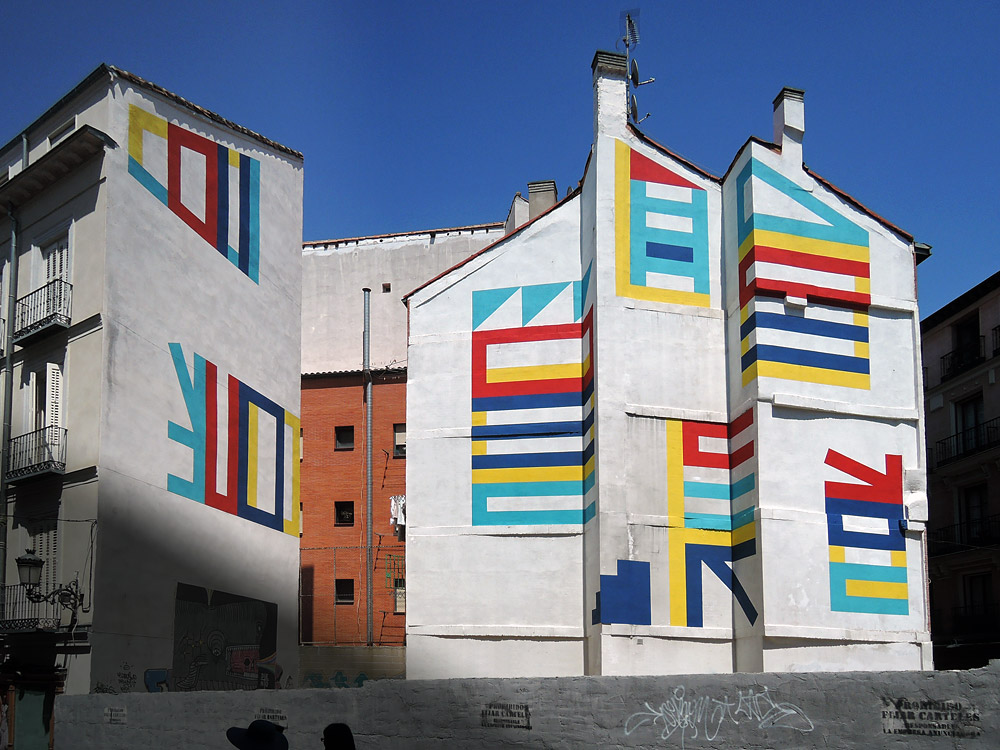
Joan Maragall 31
Incontrôlables
Instituto Cervantes de Paris
7, Rue Quentin Bauchart, 75008 Paris
June 12th – September 4th 2015
Incontrôlables is a series of experimental actions in which the artist loses, on purpose, the control of the creative process allowing outside secondary factors to work. The end result is unpredictable and the artist finds himself in the observer’s position surprised by his own creations.
Exhibition curated by Slowtrack (Madrid) and Juan Manuel Bonet.
paris.cervantes.es
slowtracksociety.com
Moulures:
Fascinated by the places on the facades of buildings where different volumes and levels come together, the artist collected the silhouettes of moldings around the city and brought the negative of the silhouette into the gallery on a wooden placard.
Rules: the molding has to meet a flat surface. The negative form obtained should not be studied in advance.
U.V.:
Works of art should be protected from sunlight. Here, in contrast, the artist takes the aggressiveness of the sun’s light to produce prints.
Rules: a template on a painted fluorescent orange paper is placed and exposed to the sun. Every day a new piece of paper is put out in order to observe the progression of the experiment. 7 papers were exposed for a week in Albuquerque and 15 for two weeks in Belvès (France).
G.A.S. (Street prints):
Revolving around the idea of using the street as a workshop, the artist conceived a printing system that takes advantage of passing cars to generate prints.
Rules: the result is shown exactly as it was found when removed from the street, even in case of failure. The date, time and location of the print are written on each print.
RUFO (Rudimentary Unidentified Frictional Object):
To study how the city can literally alter a work of art, the artist “walks” a painting around on a leash. The painting is face down with the artwork touching and scraping against the street.
Rules: paint a table and “walk it”, with the painted side face down on the city streets. The route is determined in advance. The artist can not look under the board before the end of the walk. The course completed for each painting must form a loop.
8/4 and 5/4:
An exercise in random painting where the artist paints up to 8 lines each composed of 4 points. The coordinates of the points and the color or each line are chosen at random.
Rules: the coordinates of each point are randomly generated. The points are marked on paper and numbered from 1 to 4. Then, they are joined together in numerical order. Up to 8 colors can be used in random order of appearance.
Graviers:
An experiment regarding the movements of the city. Having painted a rectangle on the floor, the artist observed its gradual degradation until it completely disappeared.
Rules: Painting done on a horizontal surface made of gravel. Paint a red box with a template and take a picture of the result. Return at least once a day to photograph the changes until the rectangle has totally disappeared
Thanks to Slowtrack, Marta Moriarty, Inés Muñozcano, Juan Manuel Bonet, Rafael Schacter, Raquel Caleya and everybody at the Instituto Cervantes de París.
Pictures by Sierra Forest, Rafael Schacter and Eltono.
Oxymores
Ministry of Culture
182, rue Saint Honoré, Paris, France
April 3rd – May 3rd 2015
Périmètre au Sol is the exact measurement of the line separating the public space from the private space around the Ministry of Culture building on Saint Honoré Street in Paris. I drew the generated line on four big papers (3,70 m x 1,40 m), each one representing one façade. The color code I used is two warm colors for the South and West façades and two cold colors for North and East.




